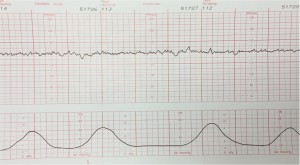The normal fetal heart rate baseline is from 110 to 160 BPM and has “variability.”
Variability means that from one moment to the next, the fetal heart speeds up slightly and then slows down slightly, usually with a range of 6-25 deviation from the baseline.
Variability is normally controlled by the fetal brain through sympathetic and parasympathetic influences. This is mostly all regulated through the fetal hypothalamus.

Variability is classified as:
- Undetectable (Absent)
- Minimal (up to 5 beats/minute)
- Moderate (6 to 25 beats/minute)
- Marked (more than 25 beats/minutes)
Reduced Variability
Reduced variability occurs normally during fetal sleep and usually returns after 20 to 40 minutes.

Reduced variability may also occur:
- Following narcotic administration
- With fetal anomalies or injury
- With hypoxia and acidosis in combination with such FHR abnormalities as late decelerations, tachycardia, bradycardia, and severe variable decelerations.
Persistent or progressively reduced variability is not, by itself, a sign of fetal jeopardy. But in combination with other abnormalities may indicate fetal intolerance of labor.
Increased Variability
Increased variability is associated primarily with fetal movement, and a higher level of fetal alertness.
It may be provoked by physical stimulation, such as a maternal abdominal exam, or pelvic exam with fetal scalp stimulation.
It may also be provoked by loud and annoying noises, such as briefly activating an artificial larynx while it is pressed against the maternal abdomen. This particular maneuver is known as a “Fetal Acoustic Stimulation Test” or FAS.
Increased variability, either naturally occurring or as a consequence of fetal stimulation is viewed as a reassuring sign. The fetus is tolerating its’ current situation well.
